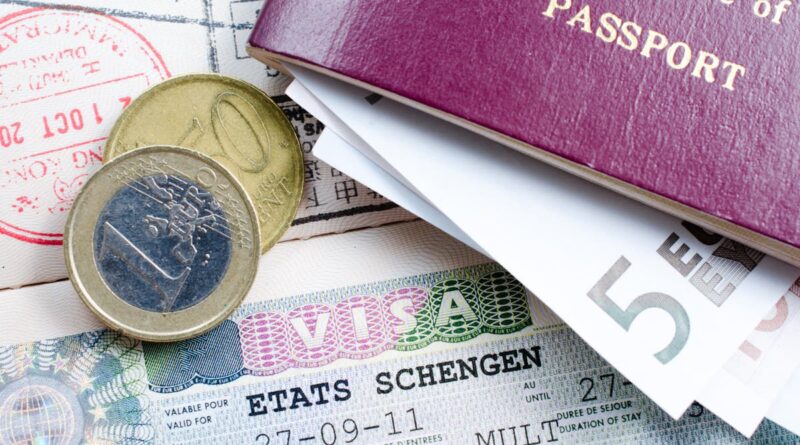What will the EU’s new entry-exit system mean for British travellers?
Support truly
independent journalism
Our mission is to deliver unbiased, fact-based reporting that holds power to account and exposes the truth.
Whether $5 or $50, every contribution counts.
Support us to deliver journalism without an agenda.
From 10 November 2024, British travellers to Europe will face more red tape.
After the UK voted to leave the European Union, Boris Johnson’s government negotiated for British travellers to become “third-country nationals” subject to a range of restrictions. British passport holders must currently have their travel documents inspected and stamped.
The European Union will launch an “entry-exit system” (EES) that will record the movements of non-EU visitors to the Schengen Area (comprising all EU nations except Cyprus and Ireland, as well as Iceland, Norway and Switzerland).
The good news: passport stamping will end. The bad news: every traveller must, in theory at least, be fingerprinted and provide a facial biometric.
Assuming the introduction of EES goes smoothly, six months later – in May 2025, according the latest plan – the Electronic Travel Information and Authorisation System (Etias) will be launched. This next step in tightening frontier controls is a online permit system similar to the US Esta scheme, but cheaper at €7 (£6) and valid for longer: three years.
But even though Etias is planned to start in May 2025, a six-month grace period will be granted – so it will not be mandatory for prospective UK visitors to apply online for permission to enter the Schengen Area until November 2025 at the earliest.
What is the “entry-exit system”?
EES is an automated Schengen Area IT system for registering citizens from other countries. The system is aimed at such travellers when they either enter or leave at an external Schengen border – such as flying from the UK to Spain or crossing by road from Greece to Turkey. It will not be used at internal frontiers within the Schengen area.
EES will register the date and place of entry or exit, plus fingerprints and a facial biometric.
This system, says the European Union, “will replace the current system of manual stamping of passports, which is time-consuming, does not provide reliable data on border crossings, and does not allow a systematic detection of over-stayers”.
British travellers, like other “third-country nationals,” are restricted to 90 days’ stay in any 180 days within the Schengen area. But enforcement of this currently depends on checking passport stamps and is applied haphazardly.
The new system will not apply in Ireland or Cyprus; citizens of those countries will not need to do anything different at Schengen Area frontier
For clarity, citizens of those countries will not face onerous checks when entering the Schengen Area; as now, they will simply be matched with their passport or ID card. So any British traveller with the fortune to have an Irish (or other EU) passport will not need to register.
When will EES start?
Sunday 10 November 2024.
Originally the entry-exit system was due to start in 2021. But the body responsible for implementation – the European Union Agency for the Operational Management of Large-Scale IT Systems in the Area of Freedom, Security and Justice (EU-Lisa) – has repeatedly pushed back the date because the database was far from ready.
In October 2023, the European Council’s Justice and Home Affairs Council endorsed a new timeline for the roll-out of EES.
The council said in a statement: “The new roadmap for the delivery of the new IT architecture foresees that the entry-exit system will be ready to enter into operation in autumn 2024.”
Now officials in Brussels have confirmed the start date as Sunday 10 November 2024 . A “last resort” option, to postpone by a week to 17 November to ensure member states are ready, appears now to be off the table.
How will the border checks work?
Inbound and outbound passengers will go through the formalities at airports, land borders and ports in the Schengen Area on arrival and departure.
Three locations in the UK have “juxtaposed” border controls, with French frontier police conducting checks on British soil: at the Port of Dover, Eurotunnel’s Folkestone terminal and the Eurostar hub at London St Pancras.
On the first registration, travellers must submit to fingerprint checks and provide a facial biometric. On subsequent visits within three years, only one of these will be required – and for practical purposes the facial biometric will be used.
Each new visit triggers another three years of validity, until the passport ceases to be valid for travel to the EU (either on its 10th birthday or when less than three months remains before the expiry date.
When using a new passport, a fresh biometric registration is required.
Sounds complicated …
Some EU members have expressed alarm at the extra time involved in the new processes, with the Slovenian government warning: “It takes up to four times longer to do the new process.”
For terrestrial travellers it could be even worse. Giving evidence to Parliament about the new system, Tim Reardon, head of EU exit for the Port of Dover, said: “There is no such thing as an e-gate for a car, and there is no such thing as an e-gate process for people travelling as a group. They’re all one-at-a-time processes.
“There is no way of doing a biometric control without getting everyone out of the vehicle.
“That’s the one thing on our site which cannot happen, because you’re in the middle of live traffic. It would be equivalent to asking people to get out of their car at a motorway toll booth. It’s fundamentally unsafe and it can’t happen.”
In January 2024, MPs were warned that Brits travelling to Europe could face waits of 14 hours or more at border control unless measures are introduced to prevent delays. Parliament’s European Scrutiny Committee was told by Ashford Borough Council that 14-hour queues were a “reasonable worst case” scenario if the scheme were to be implemented as planned in October.
Gareth Williams, strategy director for Eurostar, which runs trains to France from London, said: “We don’t currently see a practical solution. If we take the peak of August, up to 80 per cent of people will have to go through the system.
“We do have a very extreme space challenge. At a minimum we would require over 30 kiosks, and an area about the size of our entire check-in area at St Pancras.”
Transport operators from ferry firms to airlines have lobbied Brussels on the entry-exit system, calling for “urgent action” on several unresolved issues.
In particular they propose biometric data could be collected gradually during a 12-to-18-month transition period. They also say a “robust public communication campaign” is essential.
“The absence of these measures will seriously degrade traveller experience and carriers’ operations,” they have told EU officials.
But there’s talk of a Brussels fudge?
Yes. Doug Bannister, chief executive of the Port of Dover, told The Independent that a “relief valve” is expected. It appears that the passport registration will go ahead for all travellers, but biometric registration could initially be reduced to just one in 10 travellers if queues build up.
Local immigration officials will decide the appropriate number of travellers required to register their biometrics, on a range from 10 to 100 per cent.
Speaking to The Independent on 11 July, Doug Bannister, chief executive of the Port of Dover, said “an element of precautionary measures” was involved in the launch of EES.
“They will be able to dial down the amount of intervention for registration if the queueing gets excessive.
“That’s going to available for all gateways into the European Union.
“Exactly how it’s going to work? We’re still working through that with our our French and European Union counterparts.
“But that is going to be an important relief valve as the process is first introduced.”
When does Etias start?
The much-delayed scheme to verify if a third-country national meets entry requirements before travelling to the Schengen Area is now anticipated to start six months after EES is up and running: May 2025 on current projections. As mentioned, Etias will not become mandatory before late 2025.
The European Union says: “The launch of Etias in mid-2025 will be followed by a transitional period of at least six months.
“This means that, for travel during this time, travellers should already apply for their Etias travel authorisation, but those without one will not be refused entry as long as they fulfil all remaining entry conditions.”
Is Etias a visa?
Officially, no. Europe says that Etias is “a pre-travel authorisation system”. It is a similar concept to the US Esta, the Canadian eTA and the British ETA, which are not technically visas. They are issued to international travellers who do not require a full visa.
But as Etias requires visitors to apply in advance, provide lots of personal information, pay money and be issued with a permit to cross a border, it is not surprising that it is commonly termed a “eurovisa”.
How much will it cost?
The fee is €7 (£6) for all applicants aged 18 to 70. While those under 18 or over 70 will still need to apply for and hold an Etias, it will be free.
How will I apply?
When finally the EU is ready, at the heart of the system is an Etias app and website. Travellers will be required to submit personal information including name, address, contact details in Europe and passport data. They must also state an occupation (with job title and employer). Students must give the name of their educational establishment.
The applicant must give details of any serious convictions in the past 20 years.
Travellers must also provide online the reason for their journey (holiday, business, visiting family, etc), specify the country they will first arrive in, and provide the address of their first night’s stay – which will pose a problem for tourists who like to make plans as they go along.
What happens to the information?
Every application will be checked against EU and relevant Interpol databases, as well as “a dedicated Etias watch-list”.
The system will be tuned to pick out individuals suspected of being involved in terrorism, armed robbery, child pornography, fraud, money laundering, cybercrime, people smuggling, trafficking in endangered animal species, counterfeiting and industrial espionage.
Is this going to be the next online scam?
Yes, As with other online travel permits, commercial intermediaries are allowed – but according to Frontex, the EU organisation implementing Etias, there are many scam sites out there that are likely to apply fees way above the basic €7 (£6).
Any site other than europa.eu/etias is unofficial and should not be trusted.
One “imposter” site claims to have processed 671 applications already; this is impossible since no applications have been processed anywhere.
Another site offers a 40 per cent discount for early applications. Some use the EU logo, which is illegal.
Frontex also warns about the risk of identity theft if personal information is provided to imposter sites.
How far in advance must I apply?
The European Union says: “We strongly advise you to obtain the Etias travel authorisation before you buy your tickets and book your hotels.”
The aim is for an Etias to be granted within minutes, though even a straightforward application could take up to four days.
If an application is flagged (ie there is a “hit” with one of the databases) the applicant may be asked to provide additional information. Alternatively, says the EU, the applicant may be asked “to participate in an interview with national authorities, which may take up to additional 30 days”.
Assuming yours is granted, there is no certificate issued, and nothing needs to be printed. The frontier guard will get the information he or she needs from the passport you used to apply.
In a case of mistaken identity, will I be able to appeal?
Yes. Details of how to appeal will be included with the notice of rejection.
Once I have an Etias, am I guaranteed admission to the Schengen Area?
No. “Mere possession of a travel authorisation does not confer an automatic right of entry,” says the EU. As with the US, travellers can be turned away for any reason.
There is likely to be a mechanism in place for an Etias to be rescinded.
Do I need to apply for an Etias every time I travel to Europe?
No. The permit will be valid for three years, or until your passport runs out, whichever is the earlier.
Will I need an Etias to travel to Ireland?
No. The Common Travel Area incorporating the UK, Ireland, the Isle of Man and the Channel Islands transcends European Union rules, and in any event, Ireland is not in the Schengen area.
If I have a long-stay permit from one of the EU nations, must I obtain an Etias?
No.
How are people without internet access supposed to apply?
They will be expected to get a friend, a family member or a travel agent to make the application for them, in the same way as the US Esta and similar schemes.
Just remind us about the 90/180 day rule?
This rule, to which the UK asked to be subject after leaving the European Union, means that British travellers cannot stay more than 90 days in any stretch of 180 days.
As an example of what it means: if you were to spend the first 90 days of 2024 (January, February and almost all of March) in the Schengen area, you would not be able to return until late June.
Is the UK being punished because of Brexit?
No. Work on strengthening the European Union’s external border was already under way before the UK referendum on membership in June 2016. Initially British officials participated in plans for the entry-exit system.
Neither the EES nor Etias would be relevant if the UK was still in the EU. But the nation voted to leave the European Union and the British government negotiated for British travellers to be classified as third-country nationals – triggering extra red tape.




